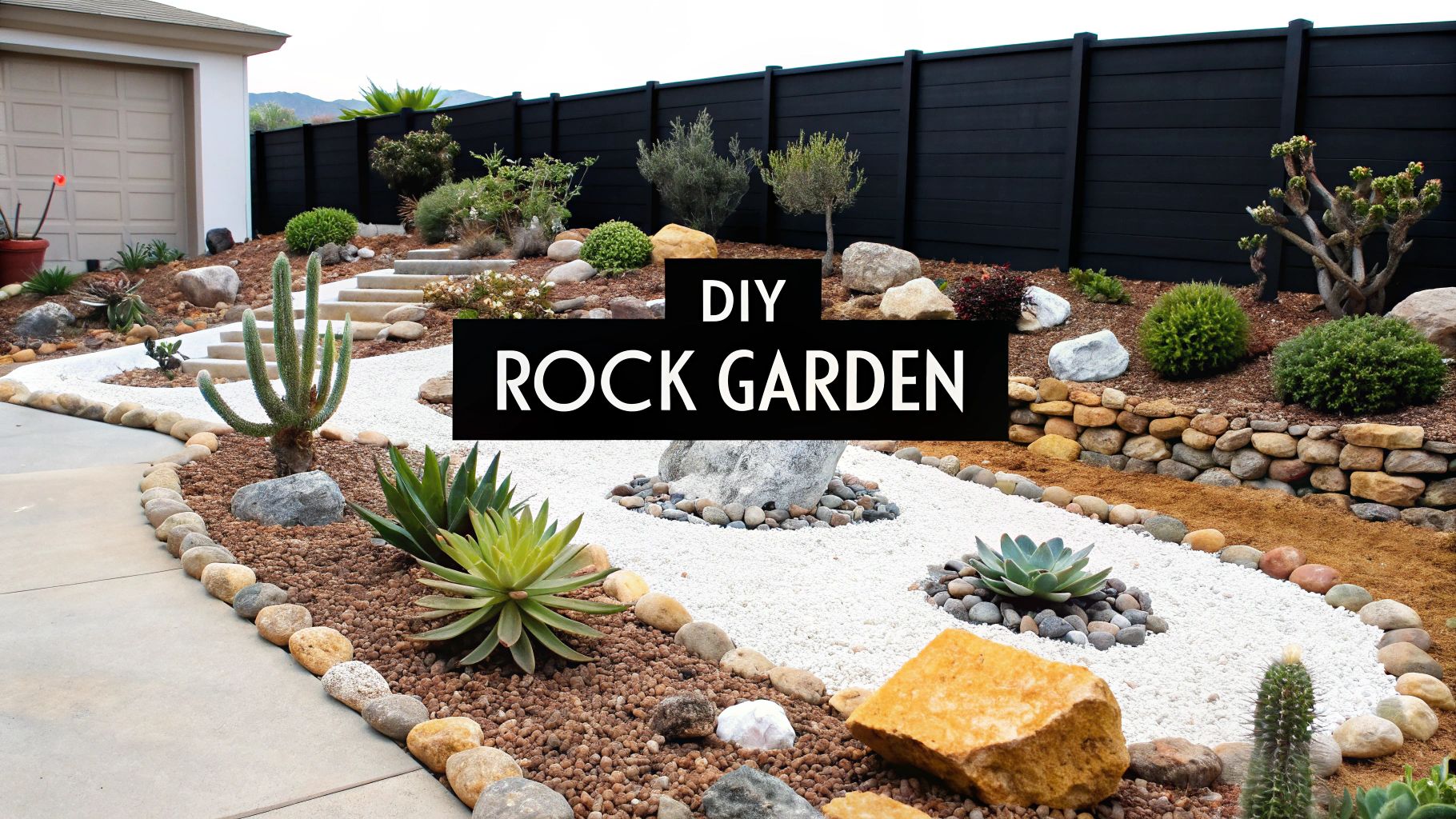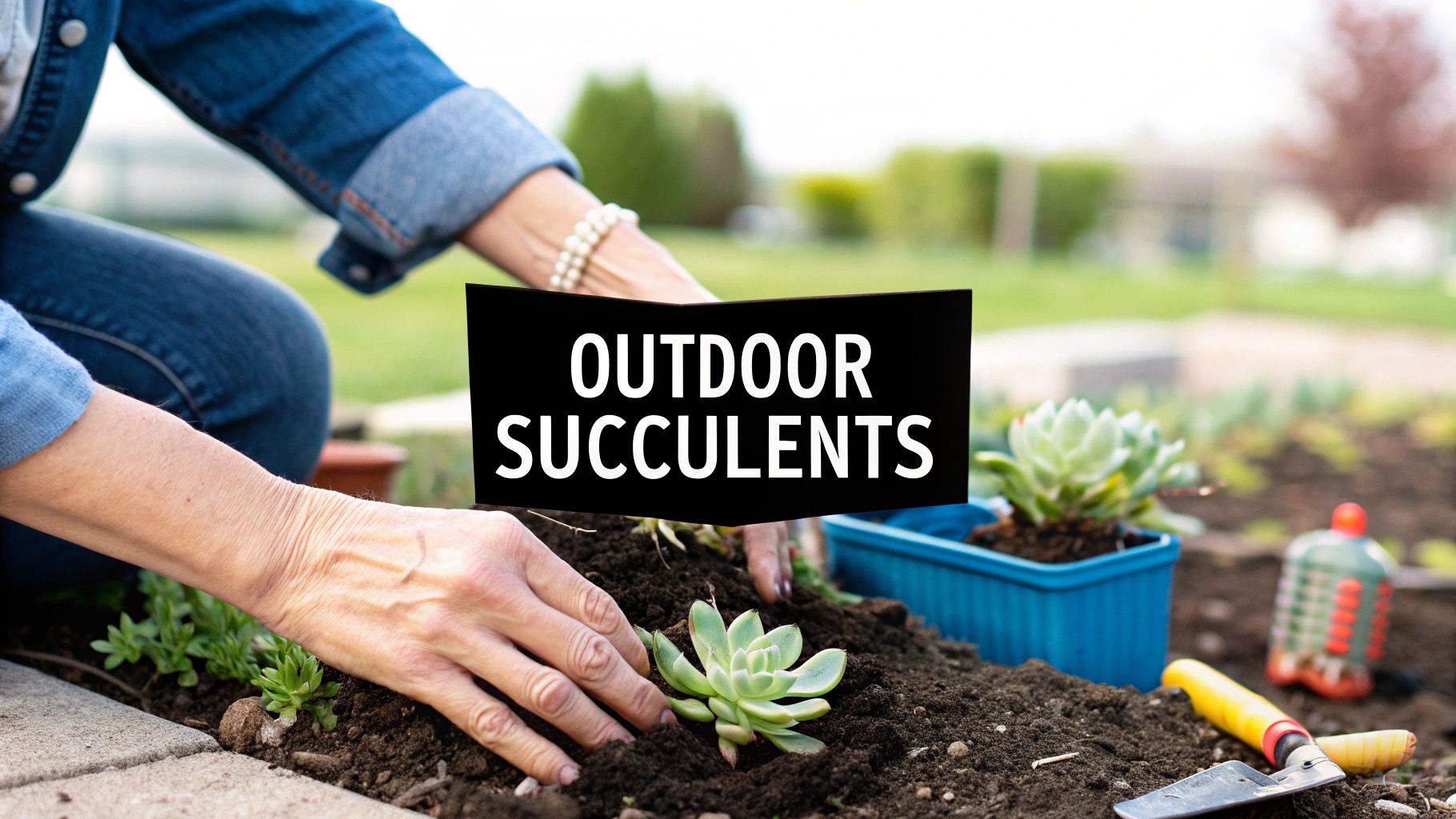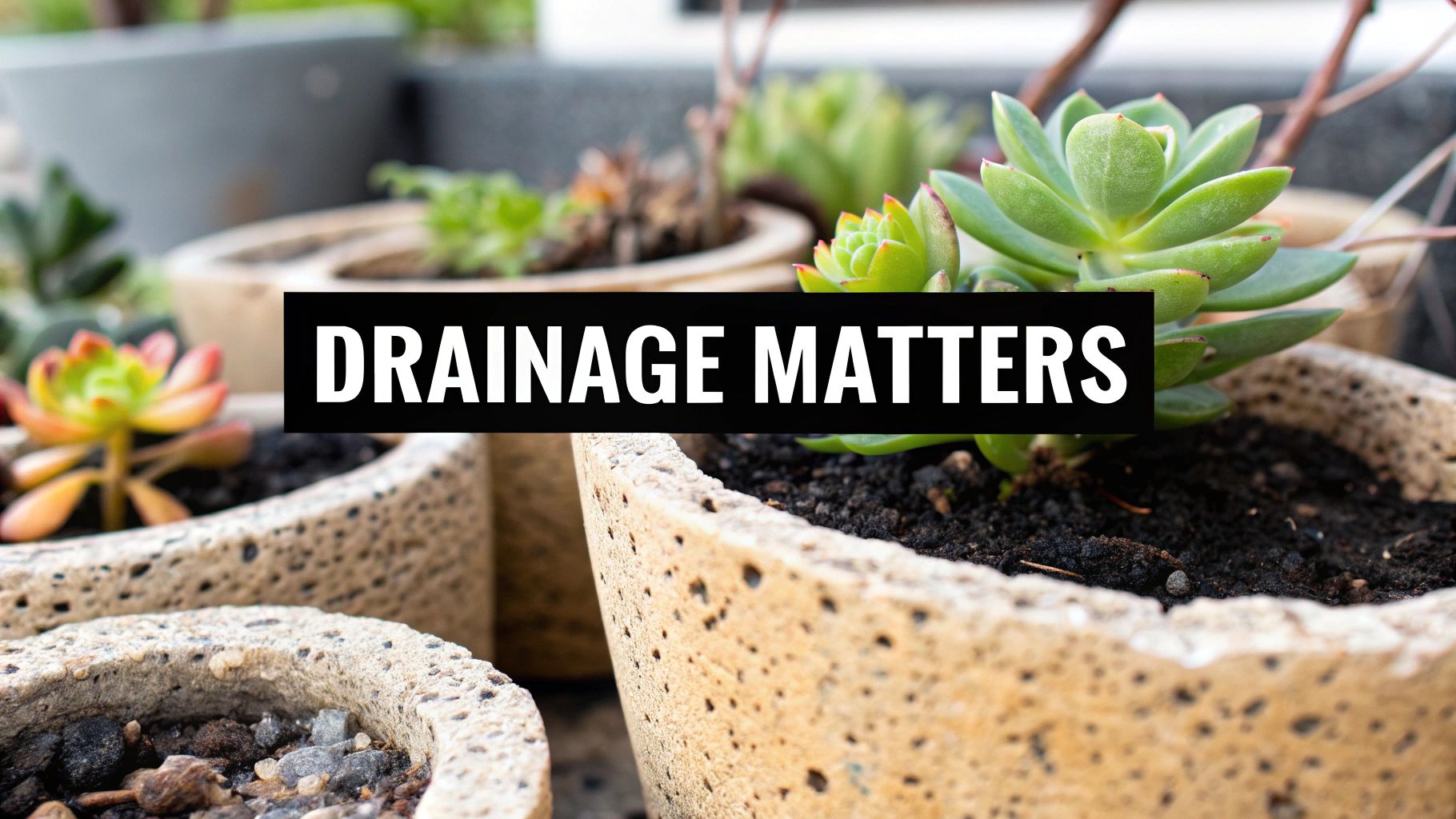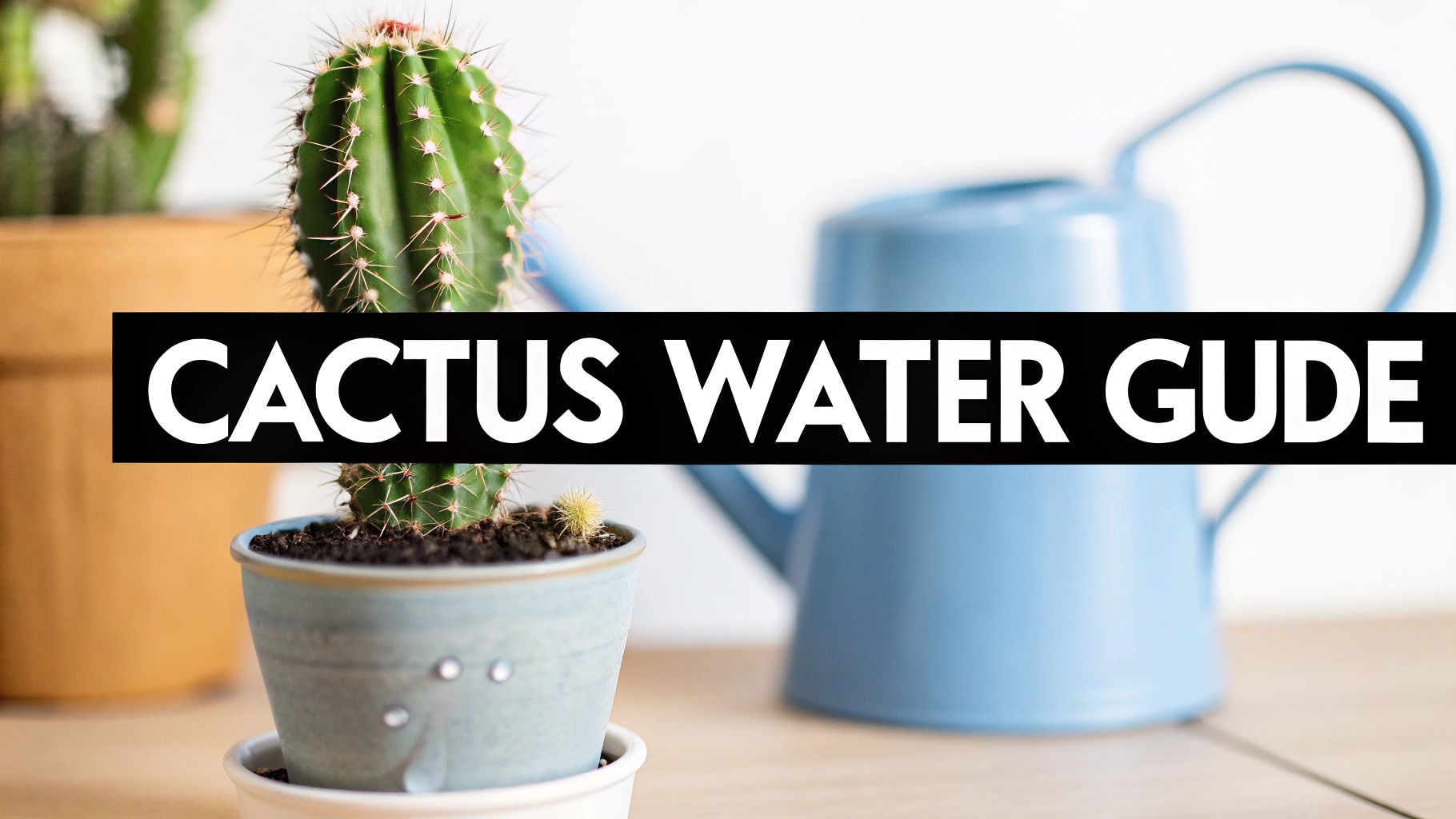Tired of the endless cycle of mowing, watering, and weeding? A rock garden offers a stunning, low-maintenance alternative that combines rugged natural beauty with artistic design. It's more than just placing a few stones; it's about creating a sustainable, visually striking landscape that thrives with minimal intervention. Whether you're dealing with a steep slope, poor soil, or simply desire a water-wise oasis, the right rock garden can solve common landscaping challenges while adding significant value and curb appeal to your home.
This guide explores a variety of distinct diy rock garden ideas, providing actionable steps to transform any outdoor space. We move beyond generic advice to give you practical, buildable concepts that you can implement yourself. You will learn how to create specific layouts, select the right plants, and style your garden for maximum impact.
We'll delve into designs ranging from the serene minimalism of a Japanese Zen garden to the vibrant, drought-tolerant world of a xeriscape filled with architectural cacti and succulents. Get ready to discover how to build a lasting landscape that reflects your personal style and works in harmony with your local environment. Each idea is presented as a complete concept, equipping you with the knowledge to start your project with confidence.
1. Alpine Rock Garden with Miniature Plants
An alpine rock garden is a specialized design that recreates the stark, beautiful environment of a mountain slope. This approach involves strategically placing rocks to form pockets, crevices, and terraces, which are then filled with small, hardy plants that naturally thrive in high-altitude conditions. It's one of the most classic diy rock garden ideas because it mimics a specific, dramatic ecosystem, creating a miniature mountain landscape right in your backyard.
This style is perfect for gardeners who appreciate intricate details and want to cultivate unique, compact plants. It transforms a sunny slope or a raised bed into a focal point that offers visual interest throughout the year. The combination of rugged stone and delicate, low-growing flora provides a stunning contrast that captures the essence of a natural alpine meadow.
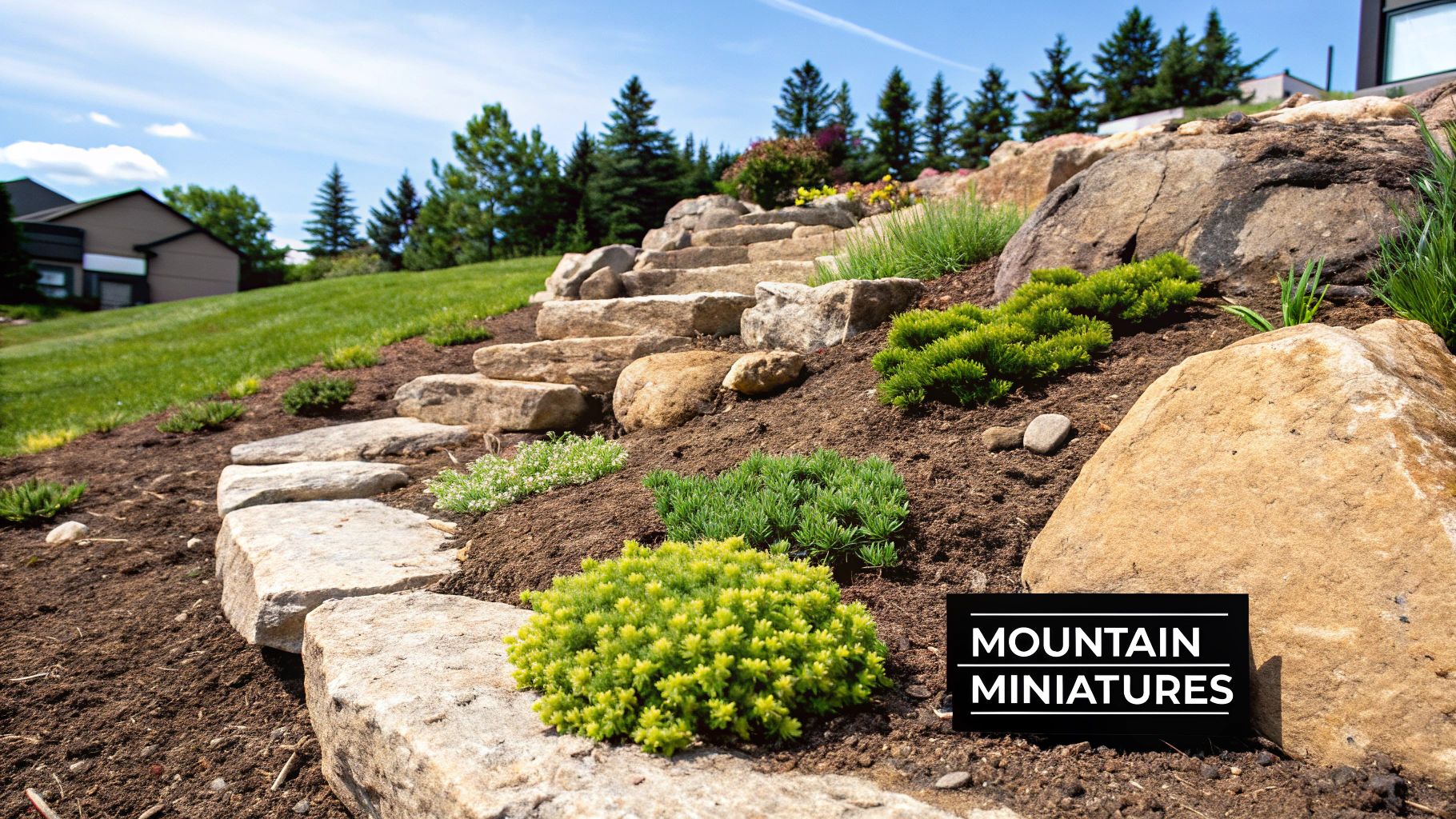
How to Create Your Own Alpine Garden
Successfully building an alpine garden hinges on mimicking its native environment, which means prioritizing stability and excellent drainage. Famous examples, like the rock garden at the Royal Botanic Garden Edinburgh, showcase how large stones can anchor a design and create ideal growing conditions.
Follow these steps for a successful implementation:
- Foundation First: Begin by placing your largest rocks, or "keystones," to define the garden's structure. Bury at least one-third of each large rock to ensure it is stable and looks naturally embedded in the landscape.
- Create Planting Pockets: Arrange smaller stones around the keystones to build up layers and form crevices. These pockets will hold the soil and protect the small plants' roots from extreme temperatures.
- Optimize the Soil: Alpine plants require sharp drainage to prevent root rot. Create a custom soil mix by combining one part garden soil, one part compost, and two parts coarse sand or fine gravel. This gritty mixture allows water to pass through quickly.
- Plant Selection: Choose compact, low-growing plants suited to your climate. Look for species like Sedum, Sempervivum (hens and chicks), Saxifraga, creeping thyme, and dwarf conifers. These plants are adapted to rocky, well-drained soils and full sun.
- Watering Strategy: Water new plants until they are established. Afterward, water deeply but infrequently, allowing the soil to dry out between sessions. This encourages deep root growth, making the plants more resilient to drought.
2. Zen Japanese Rock Garden (Karesansui)
A Zen Japanese rock garden, or Karesansui, is a dry landscape garden that uses rocks and gravel to create a tranquil, meditative space. This minimalist design forgoes most plants, instead using carefully raked gravel to represent water and strategically placed rocks to symbolize islands, mountains, or other natural elements. It's a profound example of diy rock garden ideas that emphasizes simplicity, contemplation, and finding harmony in natural materials.
This style is ideal for those seeking to create a peaceful sanctuary for reflection rather than a traditional, colorful garden. It transforms a flat, quiet corner of a yard into a powerful artistic statement. The stark beauty of stone and sand, arranged in harmonious patterns, encourages a sense of calm and mindfulness, making it a garden for the spirit as much as for the eyes.
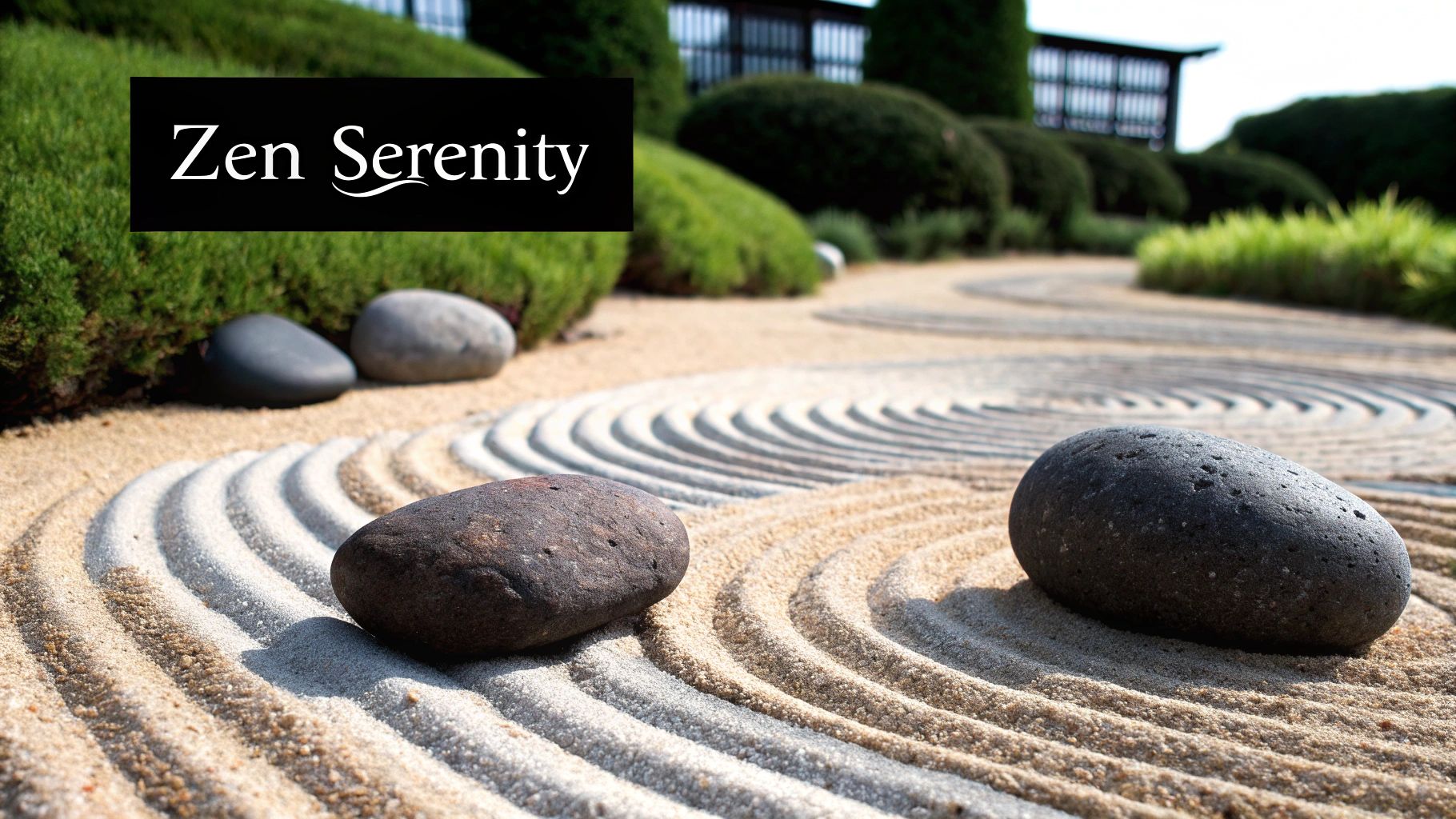
How to Create Your Own Zen Garden
Creating an authentic Karesansui is an exercise in thoughtful placement and minimalism. The goal is to capture the essence of a vast landscape in a contained space. Famous gardens like the one at Ryoan-ji Temple in Kyoto masterfully use negative space and asymmetrical balance to achieve a sense of profound tranquility.
Follow these steps for a successful implementation:
- Prepare the Foundation: Clear the designated area and install a landscape fabric to prevent weeds from growing through the gravel. This is a crucial step for maintaining the garden's clean, minimalist aesthetic.
- Set the Stones: Arrange your main rocks in asymmetrical, odd-numbered groups (e.g., three, five, or seven). Bury their bases slightly to give them a sense of permanence and natural grounding. These stones are the garden's focal points.
- Choose the Right Gravel: Select fine gravel, decomposed granite, or coarse sand that is easy to rake. Lighter colors like white or grey are traditional as they create a strong contrast with the rocks and any surrounding greenery.
- Add and Rake the Gravel: Spread the gravel evenly across the entire area, covering the landscape fabric completely. Use a wide wooden rake to create patterns, such as straight lines for stillness or concentric circles and waves to represent flowing water.
- Incorporate Minimal Plants: If you choose to add plants, use them sparingly. Moss, a small Japanese maple, or a carefully pruned pine can complement the design without overwhelming it. Position them along the garden's edge to frame the scene.
3. Spiral Rock Garden
A spiral rock garden, often called an herb spiral, is an ingenious design that maximizes planting space and creates diverse microclimates within a single, compact structure. This approach involves building a three-dimensional spiral of rocks that rises from the ground to a central peak, creating a continuous, accessible planting bed. It's a standout among diy rock garden ideas because it combines aesthetic appeal with functional permaculture principles, making it perfect for growing a variety of plants with different needs.
This style is ideal for gardeners who want to cultivate a mix of plants, like herbs and succulents, but have limited space. The vertical design offers different sun exposures, moisture levels, and temperature zones, from the sunny, dry top to the cool, moist base. The striking spiral shape provides a dynamic focal point in any garden, turning a small patch of land into a highly productive and visually stunning feature.
The infographic below illustrates the simple, step-by-step process for constructing your own spiral garden.
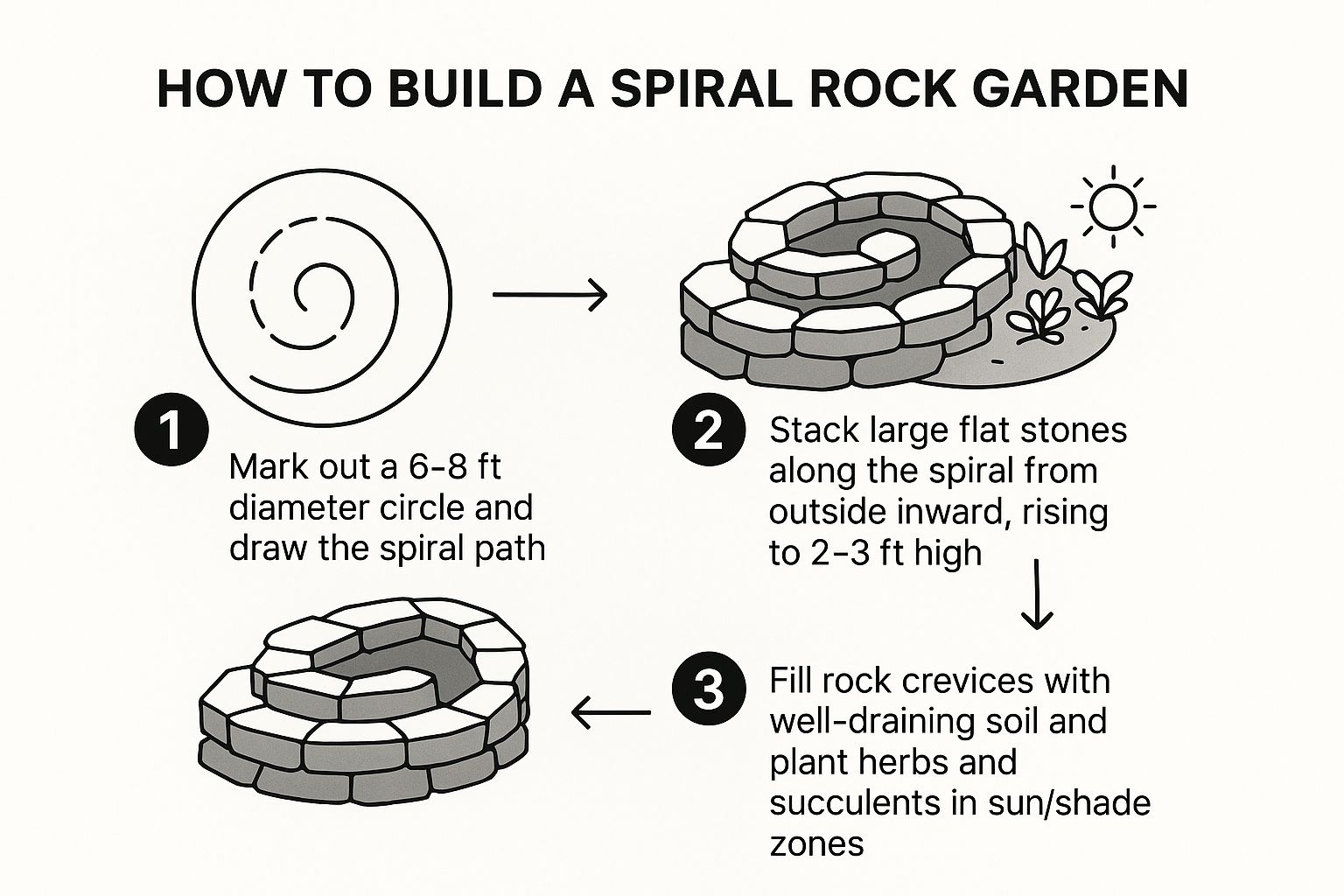
Following this process ensures a stable structure with distinct planting zones ready for a variety of plants.
How to Create Your Own Spiral Garden
Building a spiral rock garden is a straightforward project rooted in permaculture design, famously used at places like the Findhorn Foundation in Scotland. Success depends on creating a stable structure and understanding the microclimates you are building.
Follow these steps for a successful implementation:
- Lay the Foundation: Mark out a circle on the ground, typically 6 to 8 feet in diameter. Use flour or string to outline the spiral path within the circle, starting from the outside and coiling inward.
- Build the Walls: Begin stacking your largest, flattest stones along the marked spiral path. Start from the outer edge and gradually build the wall higher as you move toward the center, creating a gentle ramp. The central peak should be about 2 to 3 feet high.
- Fill with Soil: As you build, fill the space behind the rock walls with a well-draining soil mix. A blend of compost, garden soil, and sand or gravel works well for most plants.
- Strategic Planting: Plant according to the microclimates you’ve created. Place sun-loving, drought-tolerant plants like rosemary, thyme, and lavender at the sunny, well-drained top. Moisture-loving plants like mint or parsley can go at the shaded, cooler base. The spiral shape is also an excellent structure for various succulents; you can find more inspiration in these succulent garden design ideas.
- Watering Plan: Water the garden thoroughly after planting. Gravity will pull water down from the top, creating a moisture gradient. The top will remain the driest, while the bottom will retain the most moisture, naturally catering to the different plants' needs.
4. Border Rock Garden Edging
A border rock garden is a highly practical and decorative design that uses stones to create defined edges along pathways, flower beds, or property lines. This approach elegantly merges function with aesthetics, serving as a natural-looking barrier that prevents soil erosion and keeps mulch in place. It's one of the most versatile diy rock garden ideas because it can be adapted to any garden style, from rustic English cottages to minimalist modern landscapes.
This style is perfect for homeowners looking to add structure and a clean, polished look to their yard. It creates a seamless transition between different landscape elements, such as a lawn and a garden bed, while suppressing weeds and making maintenance easier. The use of carefully placed rocks adds texture, permanence, and a sense of intention to the garden's overall design, turning a simple boundary into a beautiful feature.
How to Create Your Own Border Garden Edging
Building a durable and attractive rock border is about creating a stable foundation and choosing the right materials to complement your landscape. The goal is to make the edging look as if it has always been a natural part of the environment, whether you're lining a formal path or a meandering garden bed.
Follow these steps for a successful implementation:
- Dig a Foundation Trench: Create a shallow trench, about 2 to 4 inches deep and as wide as your chosen rocks, along the intended border. This provides a stable base and prevents the rocks from shifting over time.
- Lay a Weed Barrier: Place landscape fabric along the bottom of the trench. This is a critical step to prevent grass and weeds from growing up between the stones, which significantly reduces future maintenance.
- Set the Stones: Begin placing your largest rocks first to anchor the design. Nestle them firmly into the trench, ensuring they are stable. For easy lawn maintenance, set the top of the rocks at or just below the level of the turf.
- Vary Rock Size and Shape: Create a more natural, organic look by mixing rocks of various sizes and shapes. Fill gaps between the larger stones with smaller ones to create a tight, interlocking edge. Using local stone can also help the border blend authentically with your region's landscape.
- Add Complementary Plants: Soften the hard edges of the stone by planting low-growing, drought-tolerant ground covers like creeping thyme, sedum, or ajuga in the gaps. These plants will spill over the rocks, integrating the border beautifully into the garden.
5. Water Feature Rock Garden
A water feature rock garden introduces the element of water, transforming a static landscape into a dynamic and multi-sensory oasis. This design integrates streams, waterfalls, ponds, or fountains with natural stone and moisture-loving plants. The soothing sound of moving water combined with the rugged texture of rocks creates a tranquil, naturalistic environment, making it one of the most immersive diy rock garden ideas.
This approach is perfect for creating a focal point that appeals to sight and sound. For those looking to add an auditory and visual dynamic, incorporating various water features can elevate your rock garden into a serene retreat. The combination of flowing water, stone, and lush greenery offers a powerful connection to nature, ideal for meditation spaces or outdoor seating areas.
How to Create Your Own Water Feature Garden
A successful water feature relies on proper construction and a design that looks natural. Renowned examples like the Japanese gardens at the Portland Japanese Garden showcase how water and rock can be harmonized to create breathtaking scenes. Anthony Archer-Wills, a master water garden designer, has long championed this naturalistic approach.
Follow these steps for a successful implementation:
- Seal the Foundation: Start by digging the shape of your pond or stream and installing a high-quality, flexible pond liner. Overlap and seal any seams carefully to prevent leaks and ensure long-term water retention.
- Select the Right Pump: Your water pump is the heart of the feature. Size it according to your waterfall's height and flow requirements. A good rule of thumb is to choose a pump that provides 150 gallons per hour (GPH) for every inch of waterfall width.
- Build a Natural Waterfall: Use flat, layered stones to create a cascading effect. To achieve a smooth, even sheet of water, ensure the lip or spillway stone at the top of the waterfall is perfectly level.
- Plant Selection: Choose plants that thrive in moist conditions. Plant bog-loving species like Japanese iris, cardinal flower, and horsetail rush around the edges of the water. Add submerged plants like water lilies to help keep the water clear.
- Ensure Water Clarity: Add beneficial bacteria to your pond regularly. This helps break down organic waste and prevents algae growth, keeping the water clear and healthy for plants and any potential fish. Position a bottom drain during construction for easier long-term maintenance.
6. Raised Bed Rock Garden
A raised bed rock garden elevates the planting area above ground level, using retaining walls or mounded earth and rocks. This design provides superior drainage, makes gardening more accessible, and gives you complete control over the soil composition. It stands out as one of the most practical diy rock garden ideas, especially for yards with poor native soil or for gardeners who prefer not to bend or kneel.
This style is ideal for creating a dramatic, multi-level feature in a flat landscape or for transforming a problematic area into a stunning focal point. The structure of a raised bed also helps warm the soil earlier in spring, extending the growing season for certain plants. It offers a clean, architectural look that neatly contains the rugged beauty of a rock garden within a defined space.
How to Build Your Own Raised Bed Garden
Building a stable and functional raised bed is key to its longevity and the health of your plants. Masterful examples, like the famous gravel gardens at Beth Chatto Gardens in England, demonstrate how raised structures can create perfect microclimates for drought-tolerant species. The key is a solid structure combined with the right soil mix.
Follow these steps for a successful implementation:
- Build a Strong Foundation: Begin by laying the largest, flattest stones at the base to create a stable foundation. For stone walls, stagger the joints like brickwork and build with a slight backward lean (batter) for increased strength and stability.
- Ensure Proper Drainage: Incorporate small gaps or "weep holes" every 4-6 feet along the base of the wall to allow excess water to escape, preventing water pressure from building up behind it.
- Create the Ideal Soil Mix: Fill the bed with a blend that promotes excellent drainage. A great starting point is a mix of 40% garden soil, 30% compost for nutrients, and 30% coarse gravel or sand. To learn more about perfecting the blend for arid plants, explore our guide on cactus and succulent soil.
- Select Appropriate Plants: The elevated position is perfect for showcasing trailing plants like sedum and creeping phlox, which can spill over the edges. It's also ideal for succulents, alpines, and Mediterranean herbs like lavender and rosemary that demand sharp drainage.
- Finishing Touches: After planting, add a top dressing of fine gravel or decorative stone. This mulch helps retain moisture, suppress weeds, and gives the garden a polished, cohesive look while protecting plant crowns from rot.
7. Desert/Xeriscape Rock Garden
A desert or xeriscape rock garden is a water-wise design that celebrates the stark beauty of arid landscapes. This style combines drought-tolerant plants like succulents and cacti with decorative stones, boulders, and gravel mulch. It’s a standout among diy rock garden ideas because it prioritizes sustainability and low maintenance, creating a visually striking garden that conserves water.
This approach is ideal for homeowners in dry climates or anyone looking to reduce their water consumption without sacrificing aesthetic appeal. The design emphasizes sculptural plant forms and uses rocks not just for decoration, but also to retain soil moisture and regulate temperature. The contrast between rugged stones and the unique shapes of desert flora creates a dramatic and modern look.
How to Create Your Own Xeriscape Garden
The key to a thriving xeriscape garden is creating an environment that mimics a plant's native desert habitat, with a strong focus on drainage and heat retention. Renowned gardens like the Desert Botanical Garden in Phoenix masterfully showcase these principles, blending cacti, agaves, and succulents with natural rock formations.
Follow these steps to build your own water-wise oasis:
- Amend the Soil: Desert plants require exceptional drainage. Before planting, amend your native soil with at least 30% inorganic material like pumice, perlite, or coarse sand to prevent root rot.
- Group Plants Wisely: Arrange plants with similar water and sunlight needs together. This practice, known as hydrozoning, makes watering more efficient and ensures all plants receive the right amount of care.
- Apply Gravel Mulch: Cover the soil with a 3-4 inch layer of gravel or decomposed granite. This mulch suppresses weeds, conserves precious moisture by reducing evaporation, and helps stabilize soil temperature.
- Select Appropriate Plants: For your desert or xeriscape rock garden, selecting the right flora is crucial, and you can discover top drought resistant plants that thrive with minimal water. Choose native or climate-adapted species like Agave, Yucca, Aloe, and various cacti. Explore more about Arizona succulents and cacti to find suitable options.
- Strategic Placement: Position large boulders and stones first to anchor the design, partially burying them to look as if they are emerging naturally from the ground. Place spiny plants like cacti and agaves away from high-traffic paths.
8. Miniature/Fairy Garden Rock Garden
A miniature or fairy garden rock garden is a whimsical design that uses small stones and tiny plants to create an enchanting, small-scale landscape. This approach blends rock gardening with the art of storytelling, often incorporating fairy houses, miniature furniture, and other accessories to build magical scenes. It's one of the most creative diy rock garden ideas because it allows for immense personality and can be built in containers, tucked into garden corners, or developed as a standalone feature.
This style is perfect for those who love detailed, imaginative projects and want to create a world in miniature. It’s an accessible project for gardeners of all skill levels, including children, turning a small space into a captivating focal point. The combination of natural rock textures with tiny, intricate plants and charming decorations brings a sense of wonder and delight to any garden setting.
How to Create Your Own Miniature/Fairy Garden
Building a successful miniature garden is all about scale and imagination. The key is to create a believable tiny world where every element is in proportion. Renowned miniature garden artist Janit Calvo, author of Gardening in Miniature, emphasizes maintaining scale to create a cohesive and enchanting scene.
Follow these steps to bring your miniature world to life:
- Choose a Location and Container: Select a shallow container with drainage holes, a raised bed, or a quiet corner of your garden. The location should receive the appropriate amount of sunlight for your chosen plants.
- Build the Landscape: Use larger stones to create hills, cliffs, or terraces. Arrange them to form different levels and add visual interest. Mounds of soil can also help create a varied topography for your miniature scene.
- Select Appropriate Plants: Opt for slow-growing, dwarf varieties that won't quickly outgrow the space. Plants like Sempervivum (hens and chicks), small Sedums, dwarf conifers, and creeping thyme are excellent choices. Their compact size and texture fit the miniature scale perfectly.
- Add Pathways and Features: Create a pathway using small pebbles, crushed shells, or fine gravel to guide the eye through the garden. You can also incorporate a tiny "pond" using a small dish sunk into the soil.
- Accessorize Thoughtfully: Introduce miniature accessories like fairy houses, benches, fences, or animals. Ensure all decorative elements are weather-resistant if the garden is outdoors. Use tweezers for precise placement of tiny items to avoid disturbing the plants and soil.
- Maintain the Magic: Regularly prune your plants to maintain their miniature size and shape. Water carefully, avoiding flooding the tiny scene, and check on accessories to ensure they remain in place.
DIY Rock Garden Ideas Comparison Table
| Garden Type | Implementation Complexity 🔄 | Resource Requirements ⚡ | Expected Outcomes 📊 | Ideal Use Cases 💡 | Key Advantages ⭐ |
|---|---|---|---|---|---|
| Alpine Rock Garden with Miniature Plants | Moderate to high (rock placement, plant selection) | Medium (rock sourcing, drought-tolerant alpine plants) | Durable, low-maintenance, year-round visual interest | Sloped yards, water-restricted areas, low-maintenance landscapers | Water-efficient, attracts pollinators, space-efficient |
| Zen Japanese Rock Garden (Karesansui) | Moderate (precision in raking and stone placement) | Low (mostly gravel, selected stones, minimal plants) | Peaceful, meditative, minimalist aesthetic | Small urban spaces, meditation areas, minimalist homes | Extremely low maintenance, timeless design |
| Spiral Rock Garden | High (complex spiral construction, layered planting zones) | High (large quantity of rocks, soil, and diverse plants) | Visually striking, microclimate diversity, efficient space use | Herb gardens, small backyards, educational and permaculture gardens | Maximizes space, diverse plant zones, aesthetic focal point |
| Border Rock Garden Edging | Low to moderate (linear rock arrangement, trench digging) | Low to medium (varied rock sizes, possible plants in gaps) | Defined garden spaces, erosion control | Pathways, driveways, flower bed borders, erosion-prone slopes | Cost-effective, reduces maintenance, natural boundaries |
| Water Feature Rock Garden | High (water system installation, rock and plant arrangement) | High (pump, liner, lighting, aquatic and moisture-loving plants) | Relaxing soundscape, wildlife habitat, dynamic garden | Backyard retreats, noise masking, large garden focal points | Multi-sensory experience, attracts beneficial wildlife |
| Raised Bed Rock Garden | High (construction of retaining walls, soil preparation) | High (rocks, custom soil mix, possible irrigation setup) | Improved accessibility, excellent drainage, vertical interest | Poor soil areas, accessible gardening, terraced/elevated gardens | Better soil control, ergonomic, extends growing season |
| Desert/Xeriscape Rock Garden | Moderate (plant selection, rock placement for desert styling) | Medium (drought-tolerant plants, gravel, boulders) | Water-wise, low maintenance, architectural interest | Arid climates, water conservation, sunny and hot locations | Highly water-efficient, sustainable, low upkeep |
| Miniature/Fairy Garden Rock Garden | Low to moderate (small scale, detailed decoration) | Low (miniature plants, small stones, decorative accessories) | Creative, whimsical, quick setup and change | Containers, children's gardens, small spaces, gift projects | Engaging, customizable, ideal for small spaces |
Your Rock-Solid Plan for a Beautiful Garden
You've explored a diverse landscape of diy rock garden ideas, from the tranquil raked sand of a Japanese Zen garden to the vibrant, vertical layers of a spiral herb garden. We've journeyed through the alpine peaks of miniature ecosystems and the arid beauty of a desert xeriscape. Each concept offers a unique way to transform your outdoor space, turning a simple patch of land into a testament of natural artistry and personal creativity. The common thread weaving through all these designs is the powerful synergy between stone and plant life, a combination that offers lasting beauty with minimal maintenance.
The journey from inspiration to implementation is where your vision truly takes shape. Remember that the most successful rock gardens are born from a thoughtful plan. It's about more than just placing rocks and plants; it's about creating a cohesive, sustainable environment that thrives.
Key Takeaways for Your Project
Before you break ground, let's crystallize the most important principles for success:
- Foundation First: Proper site preparation is non-negotiable. Excellent drainage is the bedrock of a healthy rock garden, especially for succulents, cacti, and alpine plants. Take the time to amend your soil and create a stable, weed-free base.
- Scale and Harmony: Choose rocks that are proportional to your space. A few large, thoughtfully placed boulders often create a more dramatic and naturalistic effect than a multitude of small stones. Arrange them in a way that mimics natural formations for a more authentic look.
- Plant with Purpose: Select plants that are well-suited to your climate and the specific microclimate of your garden. Consider the "right plant, right place" mantra. Group plants with similar light and water needs together to simplify care and ensure they all flourish.
- Embrace the Evolution: A garden is a living entity. Your rock garden will evolve over time as plants mature, spread, and settle in. Don't be afraid to edit, transplant, or add new specimens as your vision and the garden itself grow.
Your Actionable Next Steps
Feeling inspired? Here’s how to channel that energy into action. Start by assessing your space and choosing the one or two diy rock garden ideas that resonate most with you. Perhaps it’s a functional border rock garden to define a walkway or a statement-making xeriscape to conserve water.
Next, sketch out a simple design. This doesn't need to be a professional blueprint; a rough drawing will help you visualize the placement of key rocks and anchor plants. From there, you can begin sourcing your materials, starting with the stones and soil amendments. The final, most exciting step is selecting your plants. Whether you're drawn to the resilient charm of Sempervivum for an alpine setting or the architectural grandeur of a large Agave for a desert theme, choosing your botanical focal points will bring your entire project to life.
Building a rock garden is a deeply rewarding endeavor. It connects you to the earth, challenges your creativity, and ultimately provides a stunning, low-maintenance landscape that you can enjoy for years to come. Your perfect garden is not a distant dream; it's a project waiting to be built, one stone at a time.
Ready to find the perfect architectural plants to anchor your desert or xeriscape rock garden? Explore the incredible selection of mature, landscape-ready specimens at The Cactus Outlet. Their impressive range of large cacti and succulents will provide the instant impact and structural beauty your design deserves.

